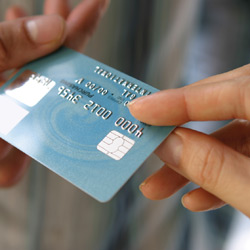
The tightening of credit has made your credit score more important then ever! The FDIC and the NCUA are encouraging lenders not only to base loan decisions on credit scores, but to use credit scores to determine the interest rates they charge. That means more banks and credit unions are using credit scores then ever before.
The Fair Isaacs model credit score is used by most lenders. It goes from 350 to 850—the higher the score, the better. Fair Isaac Risk Model V2 or V3 are the versions used by most banks and credit unions. Some car dealers may use the Auto Loan Model or the Installment Loan Model.
35 percent of your credit score is based on how you have paid your bills.
If you do not have any accounts that have monthly payments, you will probably not have any score, or at best, it will be very low.
The first thing we tell consumers who contact us about raising their score is: “Never, never pay off a delinquent account, if it can be brought current!” Obviously collections and judgment can not be brought current, so they must be paid off.
You must bring the account current and pay on it for at least six months. Fair Isaacs requires at least one account to be paid on for six months before a score can be calculated. If you pay off a delinquent account, for the next seven years, it will show on your credit report as “PAID DELINQUENT.” It will also be scored as a delinquent account even though it is paid. To increase your score, bring the delinquent account current, pay on it and keep it current for six months, and then pay it off. The account on your credit report will then show as: CURRENT, PAID, WAS DELINQUENT. However, by keeping it current for at least six months, your score would go up. The longer you keep paying without any delinquencies, the more it will help your score.
30 percent of your score is based on what you owe.
The next item to look at is your credit card debt. What are the limits and what are the balances? Fair Isaacs looks at the balance and credit limit of each credit card you hold. It then looks at your total credit card balances and credit limits.
You need your balance on each credit card—and the total balances of all cards—to be 40 percent or less of your lines of credit. For example, if you owe $4,000 and your line of credit is $5,000, you are using 80 percent of your line, and you could be docked 50 points or more. By requesting your line to be increased to $10,000, your percent of usage would be 40 percent, and your score should increase 40 to 50 points.
The problem many people are having now is that credit card companies are lowering the limits. If that causes their percentage of usage to increase, their scores may go down.
We don’t recommend the transferring of balances from one card to another, but there are times it can help. If you have a $4,000 balance and your line is $5,000, you could transfer $2,000 to another credit card with no balance that had a line of $5,000 or more. Then both credit cards would have 40 percent or less usage. Again your score should go up 40 to 50 points.
15 percent of your score is based on how long you have had credit.
Fair Isaac looks at each item of credit and scores it as to the length of time you have it. It then looks at how long you have had credit.
Do not close all your old accounts. This is one of the mistakes most often made by people who come to us for help. Unfortunately they close their accounts, their score goes down, then they call us and ask why. You may wish to close some unused and old accounts, but we recommend you keep the oldest ones open, even if you use it once a year and pay it off.
Now, for a bonus—and it may sound unusual—but it will give you a good score if you don’t have one, or raise your score if it is not very good.
Go to your bank or credit union and ask to borrow $1,000, $1,500 or $2,000. You can choose the term—one year or two years—whichever has payments you can make. You then ask them to put the money in a Certificate of Deposit for the term of the loan and use the CD as security for the loan. You should get two to 3.5 percent interest on the CD. Most lenders will charge you three to four percent more than they pay you. However, you will pay them about the same or less than they will pay you for the CD.
They will pay you interest on the CD from the first day, and you will pay interest on the unpaid balance of the loan. As the loan balance goes down, your interest payment goes down. If they charge you seven percent interest on a $1,500 loan for 18 months, your payments will be about $88 each month, and you will pay about $85 to $90 in interest. A $1,500 CD for 18 months at 2.75 percent will pay a little over $62. At the end of the loan, if you made your payments on time, your credit score will go up, and you will have over $1,560 in your savings account. Your cost for the good or improved credit rating and for the $1,500 in savings would be $20 to $30. iBi

